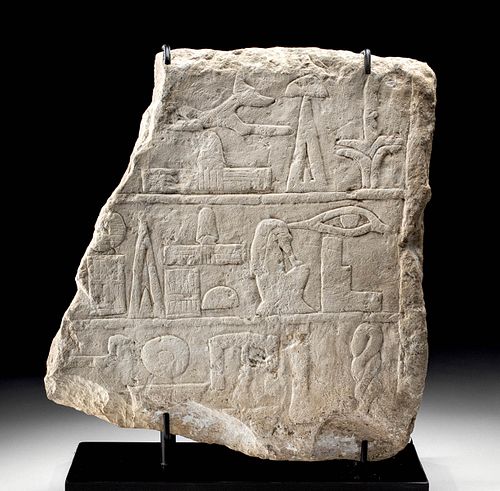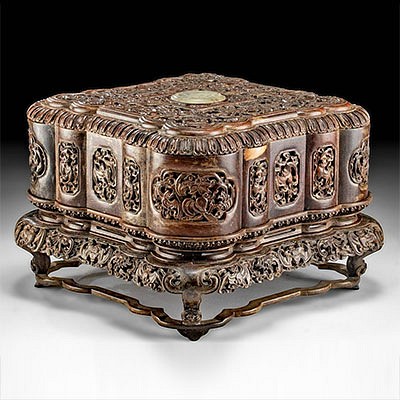Translated Egyptian Limestone Offering Stele
Lot 1a
About Seller
Artemis Fine Arts
686 S Taylor Ave, Ste 106
Louisville, CO 80027
United States
Selling antiquities, ancient and ethnographic art online since 1993, Artemis Gallery specializes in Classical Antiquities (Egyptian, Greek, Roman, Near Eastern), Asian, Pre-Columbian, African / Tribal / Oceanographic art. Our extensive inventory includes pottery, stone, metal, wood, glass and textil...Read more
Categories
Estimate:
$7,000 - $10,000
Absentee vs Live bid
Two ways to bid:
- Leave a max absentee bid and the platform will bid on your behalf up to your maximum bid during the live auction.
- Bid live during the auction and your bids will be submitted real-time to the auctioneer.
Bid Increments
| Price | Bid Increment |
|---|---|
| $0 | $25 |
| $300 | $50 |
| $1,000 | $100 |
| $2,000 | $250 |
| $5,000 | $500 |
| $10,000 | $1,000 |
| $20,000 | $2,500 |
| $50,000 | $5,000 |
| $100,000 | $10,000 |
| $200,000 | $20,000 |
About Auction
By Artemis Fine Arts
Apr 8, 2021
Set Reminder
2021-04-08 10:00:00
2021-04-08 10:00:00
America/New_York
Bidsquare
Bidsquare : Fine Antiquities | Asian | Ethnographic Art
https://www.bidsquare.com/auctions/artemis-gallery/fine-antiquities-asian-ethnographic-art-6770
Features classical antiquities, ancient and ethnographic art from cultures encompassing the globe. Egyptian, Greek, Roman, Etruscan, Near Eastern, Asian, Pre-Columbian, Native American, African / Tribal, Oceanic, Spanish Colonial, Russian, Fine Art, so much more! All legally acquired, legal to sell. Artemis Fine Arts info@artemisgallery.com
Features classical antiquities, ancient and ethnographic art from cultures encompassing the globe. Egyptian, Greek, Roman, Etruscan, Near Eastern, Asian, Pre-Columbian, Native American, African / Tribal, Oceanic, Spanish Colonial, Russian, Fine Art, so much more! All legally acquired, legal to sell. Artemis Fine Arts info@artemisgallery.com
- Lot Description
Ancient Egypt, Old Kingdom, 3rd to 6th Dynasty, ca. 2686 to 2181 BCE. A beautiful fragment of a hand-carved limestone offering stele for a deceased individual. The thick tablet features three registers of large hieroglyphs in low relief that are read right to left and separated with thin borders as well as a vertical lateral border. The intent of this tablet is determined by the first line which reads, "An offering which the King gives Anubis . . ." which is a commensurate phrase in the traditional Egyptian offering incantation. The second line reads, "The Osiris gives offerings of (strength?) . . ." and the third line reads, "A feast/festival/festal offering . . ." The intricate, low relief presentation of the hieroglyphs as well as offerings given by both the king and Osiris suggest that this stele was meant for an individual of great respect, wealth, influence deserving of ample sustenance in the afterlife. Size: 11.875" W x 12.875" H (30.2 cm x 32.7 cm); 13.9" H (35.3 cm) on included custom stand.
For an example of a relief from the late 3rd to 4th Dynasty, please see The Metropolitan Museum of Art, accession number 58.44.2a, and another can be seen at the Middlebury College Museum of Art.
For an example of an offering stele with incised hieroglyphs, please see The British Museum, museum number EA1663.
Provenance: private Hagar collection, Wildwood, Missouri, USA; ex-private North Carolina, USA collection, acquired in the 1980s
All items legal to buy/sell under U.S. Statute covering cultural patrimony Code 2600, CHAPTER 14, and are guaranteed to be as described or your money back.
A Certificate of Authenticity will accompany all winning bids.
We ship worldwide and handle all shipping in-house for your convenience.
#156424This is a fragment of a larger tablet. Nicks and abrasions to some hieroglyphs, peripheries, and verso, with softening to some hieroglyphs, and light encrustations, otherwise intact and excellent. Great earthen deposits and preservation of remaining hieroglyphs.Condition
- Shipping Info
-
All shipping is handled in-house for your convenience. Your invoice from Artemis Gallery will include shipping calculation instructions. If in doubt, please inquire BEFORE bidding for estimated shipping costs for individual items.
-
- Buyer's Premium



 EUR
EUR CAD
CAD AUD
AUD GBP
GBP MXN
MXN HKD
HKD CNY
CNY MYR
MYR SEK
SEK SGD
SGD CHF
CHF THB
THB














